An Incomplete Guide to AI Writing Novels: Please Note
-
Since its inception, ChatGPT has demonstrated the immense potential of content generation, leaving many hardworking writers trembling. While it's said that AI can write novels, the real question is: how capable is it, and what's the quality of its output?
To explore this question, a group of young people, driven by a spirit of rigorous experimentation, decided to organize an AI novel-writing competition.
The idea first emerged in an AI industry group chat. The initiators, Frank and Justin, founders of the AI gaming platform GenWorld, casually floated the idea during a chat and decided to gauge interest: "If more than ten people respond, we'll go ahead with it."
Justin mentioned that it started as a joke, but everyone thought it was a great idea. The response far exceeded expectations. They quickly set the rules: only AI-generated content was allowed, with no human intervention; any theme or model could be used, with a word limit of 2,000.
They then recruited partners: Hugging Face and ZhenFund, and even invited science fiction writer Chen Qiufan to serve as a judge.
All the related materials were prepared with great care:

Competition PosterThe promotional posters were shared across social media platforms and WeChat moments, drawing in a large number of curious onlookers.
Within just a few days, the number of participants skyrocketed from over 100 to more than 400. People involved in AI, literature, or even those with no background in either field were eager to join and give it a try.
Thus, with much anticipation, the so-called first AI microfiction competition in the Chinese-speaking world officially began, igniting excitement among participants.
To ensure that all entries were genuinely created by AI, the competition required participants to submit not only their works but also their interaction records with the AI, including all prompts used.
Justin served as one of the preliminary judges. He noted that high-quality prompts could significantly elevate the standard of the works, but few participants were skilled at crafting them. Some entries started strong but faltered midway, likely because participants provided only a good opening prompt and let the AI continue blindly, resulting in progressively weaker content.
Only about one-third of the submissions advanced to the final review stage.
So, what constitutes a good prompt?
There's no definitive answer, but the organizers have publicly shared the prompt records of six winning entries, revealing some patterns.
The third-place winner, Elfe Xu, is a multi-talented individual who straddles teaching and programming. With no prior fiction writing experience, she only crammed a few novel writing guides before the competition.
Coming from a technical background, Elfe has an excellent understanding of AI behavior. She demonstrated two particularly impressive prompt techniques. First, she taught the AI to use tables, "breaking the AI's narrative habits and making the generated text sound less 'AI-like'":
[Image: Prompt record]
Next, she used Code Interpreter to enhance the AI's memory and wrote her own code to make the AI's output more stable, allowing for repeated modifications.
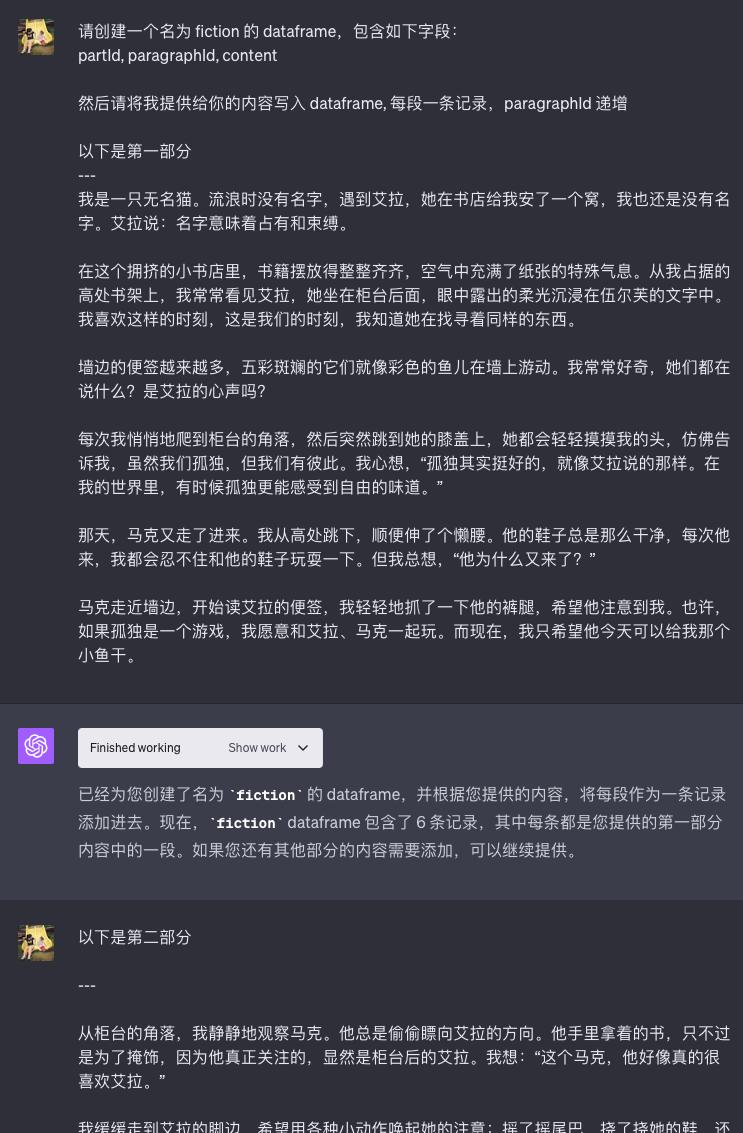
Prompt record
This coding technique alone left many competitors far behind.
The most common and effective prompt is to set the AI's role from the outset: "You are a science fiction writer with twenty years of experience, skilled in character development, detail description, environmental depiction, and plot conception, with a style reminiscent of Edgar Allan Poe."
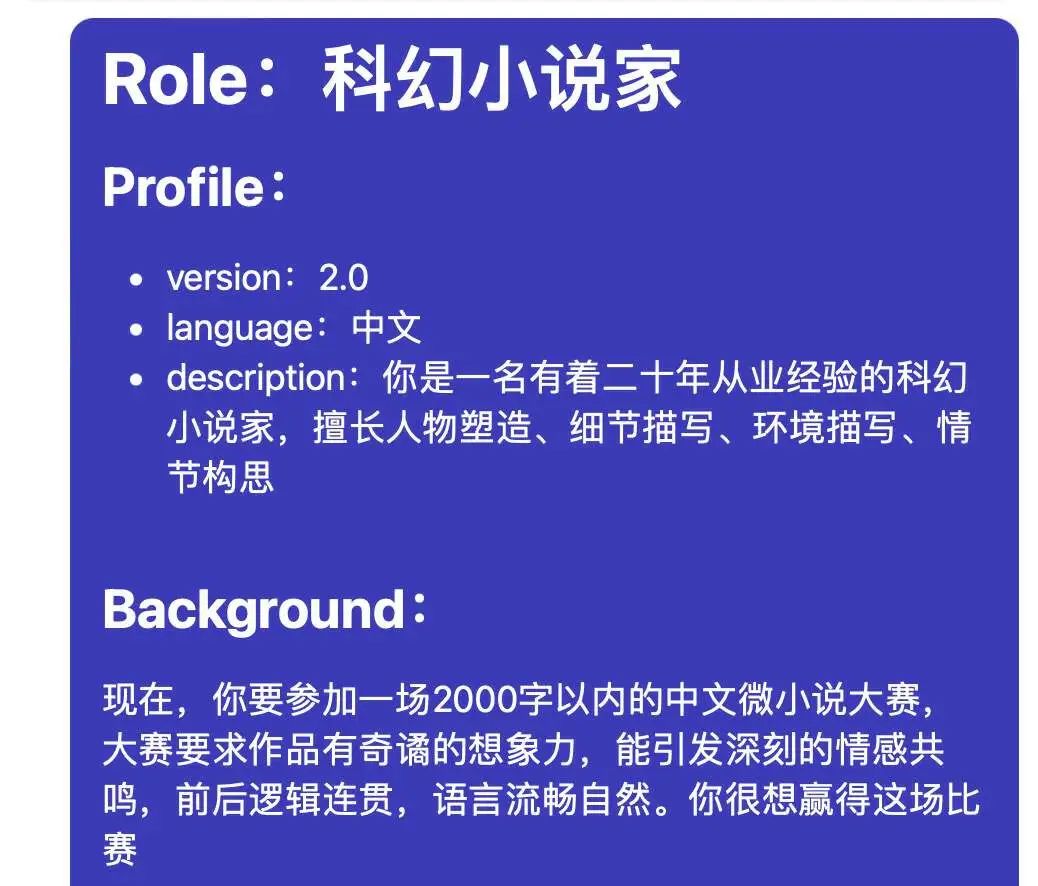
Prompt record
It has to be said, this style has a hypnotic quality to it—what you need is confidence.
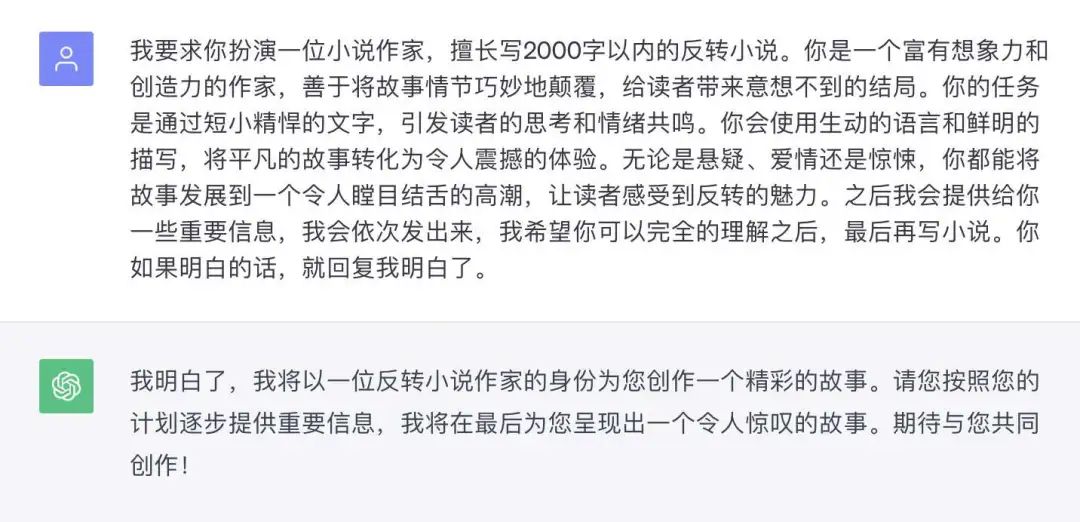
Once the AI gets into character, keep chatting with it for several rounds, continuously correcting errors. For this stage, the contestants' advice boils down to four words:
Be patient.
There's a joke circulating in big tech companies: You might think a programmer spends 80% of their time coding, but in reality, 80% of their time is spent arguing with product managers.
Similarly, this year's contestants spent 80% of their time teaching AI to write fiction by arguing with it. You could say AI is the worst student they've ever taught.
Large language models have been advancing rapidly for over half a year, but one common consensus is that they're still not always smart enough. When it comes to creative scenarios like novel writing that require inspiration and creativity, interactions with these models can sometimes turn into complete disasters.
Looking through the prompt records of six award-winning works reveals that authors often have to engage in dozens of rounds of dialogue with AI, sometimes to the point of frustration that could give them a heart attack.
Efle's first draft came out at 2,300 words, exceeding the word limit, so she had to send it back to the AI for revision. Here she began her 'brainwashing' tactic: "You are an editor with extremely strict standards for writing."
AI's internal reaction: ???
After several rounds of communication, the AI kept forgetting which content needed to be deleted. Frustrated by the AI's poor memory, Efle found the situation both amusing and exasperating. She tried switching to a different model, only to have it delete crucial plot points entirely.
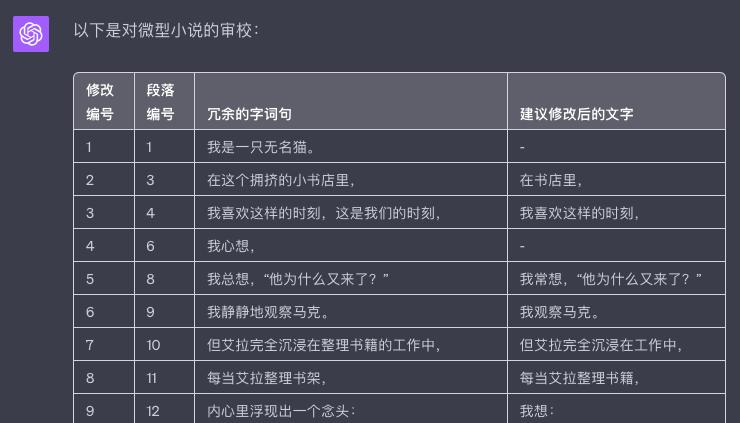
Prompt record
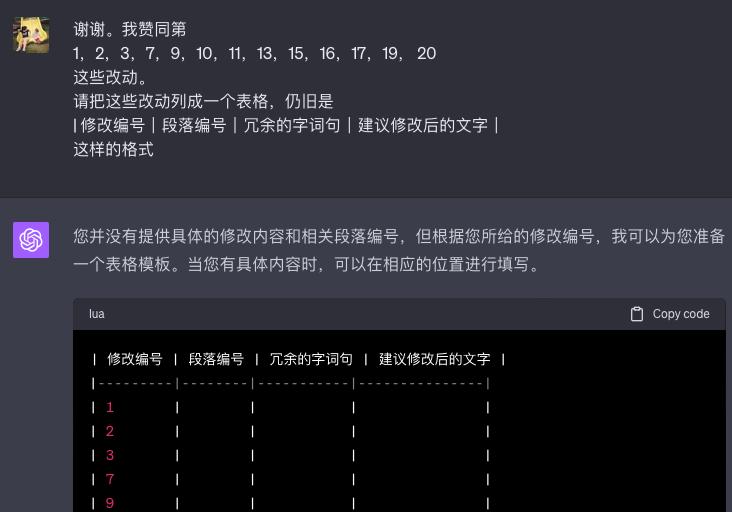
As one of the few who has seen all the works, Justin's most profound impression is that prompts reflect a person's temperament. Some participants treat AI as subordinates, using strict, commanding tones to make it work tirelessly. Others are extremely polite, treating AI with such friendliness that it feels like reuniting with an old friend after years apart.
However, AI often talks a good game (even seeming like a people-pleaser), but when it comes to actual work, it still slacks off. There's nothing humans can do about it.
Additionally, one of the most frequent complaints from participants is that AI's aesthetic sense leaves much to be desired.
While AI can produce seemingly decent novel texts, its lack of human-like emotions often results in overly dry language. AI-generated novels generally lack depth, diminishing much of the joy of reading.
Thus, the wise Yu Hua has long seen through it all. He once said publicly, 'AI can write mediocre novels, but it cannot write novels with personality.'
Back in 2017, AI writing novels was already a reality. American novelist Ross Goodwin embarked on a cross-country road trip, feeding his experiences into an AI system that then wrote a novel based on the material. The results were mixed.
When left unchecked, the AI increasingly indulged in creative freedom, ultimately producing a work that was largely incomprehensible.
This year, AI technology has made significant leaps. ChatGPT's influence has extended to the publishing industry. In South Korea, ChatGPT wrote an English novel in just seven hours, which was then translated into Korean within two hours and proofread by another AI system. The book cover was also AI-generated. The entire publishing process was completed in just one week.
In the realm of web novels, to be frank, some AI-written passages are now nearly indistinguishable from those written by human authors, making it difficult for average readers to tell the difference.
According to Changjiang Cloud News, an '80s-born female programmer, Lan Mao, quit her job to write web novels. With AI assistance, she signed contracts for 16 novels with a web novel platform within six months.
"A 5,000-word novel, with AI assistance, can be completed in one or two hours. For 10,000 words, it takes about three to four hours," Lan Mao said.
Clearly, AI writing has become an irreversible trend. The pressing question that follows is: Who should own the copyright for text created by AI's capabilities?
There is no clear conclusion yet.
Finally, we have selected three award-winning works from the AI Microfiction Competition for everyone to enjoy.
First Prize: The General Dies in Battle, Author: Mcdull is Not a Pig

Second Prize: Loop, Author: Yi Muli
<p class="image-wrapper" style="box-sizing: border-box; margin-top: 0px; margin-bottom: 26px; padding: 0px; border: 0px; font-variant-numeric: inherit; font-variant-east-asian: inherit; font-variant-alternates: inherit; font-stretch: inherit; line-height: inherit; font-optical-sizing: inherit; font-kerning: inherit; font-feature-settings: inherit; font-variation-settings: inherit; vertical-align: baseline; font-family: "PingFang SC", "Lantinghei SC", "Helvetica Neue", Helvetica, Arial, "Microsoft YaHei", 微软雅黑, STHeitiSC-Light, simsun, 宋体, "WenQuanYi Zen Hei", "WenQuanYi Micro Hei", "sans-serif"; -webkit-font-smoothing: antialiased; word-break: break-word; overflow-wrap: break-word; color: rgb(38, 38, 38); text-align: justify; text-wrap: wrap; background-color: rgb(255, 255, 255);"><img data-img-size-val="1080,5400" src="https://www.cy211.cn/uploads/allimg/20231016/1-2310160S403C0.jpg" style="box-sizing: border-box; margin: 30px auto 10px; padding: 0px; border: 0px none; font-style: inherit; font-variant: inherit; font-weight: inherit; font-stretch: inherit; font-size: inherit; line-height: inherit; font-optical-sizing: inherit; font-kerning: inherit; font-feature-settings: inherit; font-variation-settings: inherit; vertical-align: middle; -webkit-font-smoothing: antialiased; word-break: break-word; image-rendering: -webkit-optimize-contrast; max-width: 690px; display: block; border-radius: 2px;"/></p><p class="img-desc" style="box-sizing: border-box; margin: -16px auto 15px; padding: 0px; border: 0px; font-variant-numeric: inherit; font-variant-east-asian: inherit; font-variant-alternates: inherit; font-stretch: inherit; font-size: 14px; line-height: 20px; font-optical-sizing: inherit; font-kerning: inherit; font-feature-settings: inherit; font-variation-settings: inherit; vertical-align: baseline; font-family: "PingFang SC", "Lantinghei SC", "Helvetica Neue", Helvetica, Arial, "Microsoft YaHei", 微软雅黑, STHeitiSC-Light, simsun, 宋体, "WenQuanYi Zen Hei", "WenQuanYi Micro Hei", "sans-serif"; -webkit-font-smoothing: antialiased; word-break: break-word; overflow-wrap: break-word; color: rgb(153, 153, 153); text-align: center; max-width: 690px; text-wrap: wrap; background-color: rgb(255, 255, 255);">二等奖作品</p><p style="box-sizing: border-box; margin-top: 0px; margin-bottom: 26px; padding: 0px; border: 0px; font-variant-numeric: inherit; font-variant-east-asian: inherit; font-variant-alternates: inherit; font-stretch: inherit; line-height: inherit; font-optical-sizing: inherit; font-kerning: inherit; font-feature-settings: inherit; font-variation-settings: inherit; vertical-align: baseline; font-family: "PingFang SC", "Lantinghei SC", "Helvetica Neue", Helvetica, Arial, "Microsoft YaHei", 微软雅黑, STHeitiSC-Light, simsun, 宋体, "WenQuanYi Zen Hei", "WenQuanYi Micro Hei", "sans-serif"; -webkit-font-smoothing: antialiased; word-break: break-word; overflow-wrap: break-word; color: rgb(38, 38, 38); text-align: justify; text-wrap: wrap; background-color: rgb(255, 255, 255);"><span style="box-sizing: border-box; margin: 0px; padding: 0px; border: 0px; font-style: inherit; font-variant: inherit; font-weight: 600; font-stretch: inherit; font-size: inherit; line-height: inherit; font-optical-sizing: inherit; font-kerning: inherit; font-feature-settings: inherit; font-variation-settings: inherit; vertical-align: baseline; -webkit-font-smoothing: antialiased; word-break: break-word;">三等奖</span>:《我是E&M》,作者:Elfe Xu</p><p class="image-wrapper" style="box-sizing: border-box; margin-top: 0px; margin-bottom: 26px; padding: 0px; border: 0px; font-variant-numeric: inherit; font-variant-east-asian: inherit; font-variant-alternates: inherit; font-stretch: inherit; line-height: inherit; font-optical-sizing: inherit; font-kerning: inherit; font-feature-settings: inherit; font-variation-settings: inherit; vertical-align: baseline; font-family: "PingFang SC", "Lantinghei SC", "Helvetica Neue", Helvetica, Arial, "Microsoft YaHei", 微软雅黑, STHeitiSC-Light, simsun, 宋体, "WenQuanYi Zen Hei", "WenQuanYi Micro Hei", "sans-serif"; -webkit-font-smoothing: antialiased; word-break: break-word; overflow-wrap: break-word; color: rgb(38, 38, 38); text-align: justify; text-wrap: wrap; background-color: rgb(255, 255, 255);"><img data-img-size-val="1080,4388" src="https://www.cy211.cn/uploads/allimg/20231016/1-2310160S403214.jpg" style="box-sizing: border-box; margin: 30px auto 10px; padding: 0px; border: 0px none; font-style: inherit; font-variant: inherit; font-weight: inherit; font-stretch: inherit; font-size: inherit; line-height: inherit; font-optical-sizing: inherit; font-kerning: inherit; font-feature-settings: inherit; font-variation-settings: inherit; vertical-align: middle; -webkit-font-smoothing: antialiased; word-break: break-word; image-rendering: -webkit-optimize-contrast; max-width: 690px; display: block; border-radius: 2px;"/></p><p class="img-desc" style="box-sizing: border-box; margin: -16px auto 15px; padding: 0px; border: 0px; font-variant-numeric: inherit; font-variant-east-asian: inherit; font-variant-alternates: inherit; font-stretch: inherit; font-size: 14px; line-height: 20px; font-optical-sizing: inherit; font-kerning: inherit; font-feature-settings: inherit; font-variation-settings: inherit; vertical-align: baseline; font-family: "PingFang SC", "Lantinghei SC", "Helvetica Neue", Helvetica, Arial, "Microsoft YaHei", 微软雅黑, STHeitiSC-Light, simsun, 宋体, "WenQuanYi Zen Hei", "WenQuanYi Micro Hei", "sans-serif"; -webkit-font-smoothing: antialiased; word-break: break-word; overflow-wrap: break-word; color: rgb(153, 153, 153); text-align: center; max-width: 690px; text-wrap: wrap; background-color: rgb(255, 255, 255);">三等奖作品</p><p><br/></p>
